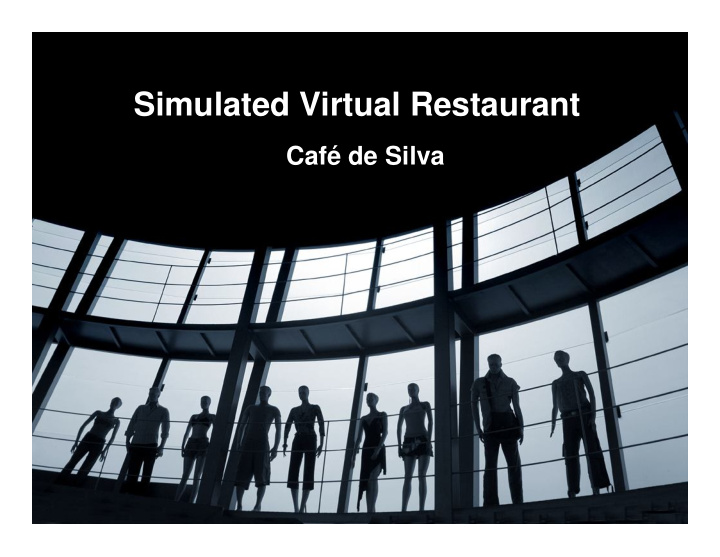



Simulated Virtual Restaurant Café de Silva
Goals and Objectives • Explore how three-dimensional computer modeling is being utilized to aid restaurant creation and development. • Identify the advantages and barriers associated with virtual restaurant modeling and simulation • Develop a pilot project to examine modeling and simulation through a VRE (Virtual Restaurant Environment)
VRML and Modeling • Planned Development • Animations • Behaviors and Functionality • Sensors
Planned Development • A restaurant displayed within a night setting modeled to encompass a complete interior and exterior scene with four floors. • A detailed building (textures, lighting, etc.) with a café lounge at the entrance floor. • Incorporate VRML behaviors and functionalities through 3Ds Max.
Café de Silva
Café de Silva
First Floor
First Floor
Second Floor
Third Floor
Third Floor
Fourth Floor
Fourth Floor
Animation • Biped • Speaker • Vehicle • Elevator • Furniture
Biped
Biped
Biped
Vehicle
Speaker
Elevator with VRML Touch Sensor
Curtain with VRML Touch Sensor
Door with VRML Touch Sensor
Door with VRML Touch Sensor
Crowd Behavior outside restaurant
Crowd Behavior outside restaurant
Crowd Behavior outside restaurant
Crowd Behavior inside restaurant
Crowd Behavior inside restaurant
Advantages and Barriers • Advantages of Adopting VR Restaurant Modeling – Enhanced communication and easy to explore restaurant context – Freedom of movement (movement between different scales and levels of details) – Different levels of immerseveness. – Ability to attach qualitative data to the models – Portability
Advantages and Barriers • Barriers of Adopting VR Restaurant Modeling – Technical Issues – Organizational Issues – Ownership of the models – Privacy and security – Time constraints
Conclusion
References • http://www.renderosity.com • http://thefree3dmodels.com • http://www.vrmlsite.com • http://www.emory.edu/BUSINESS/vr.html • http://usa.autodesk.com
Demo
Recommend
More recommend